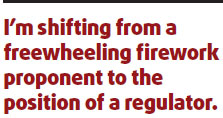
Then came the Lantern Festival, the last day of the holiday, and the tragedy that the authorities probably feared all along. Investigators have concluded industry-grade fireworks, the kind used for the Olympics, caused the massive fire that engulfed the annex building of the new CCTV headquarters. The whole operation was illegal because it never applied for the permission required for these kinds of fireworks, and CCTV staff ignored police intervention before the building caught fire.
So, who is to blame? Lax regulations or lax implementation? Everyone expects the pendulum will swing to the other extreme next year.
For many years, metropolises like Beijing forbade the use of fireworks in their downtown areas. Fire hazards were just one of the reasons. Other reasons include physical damage to properties and passersby. This has been substantiated with a news report, which mentions 103 firework-related fires in Beijing and 403 people injured.
In the long-running debate about the pros and cons of lifting the ban, I always sided with the laissez-faire school. Spring Festival without fireworks is just not complete. Suggested alternatives such as playing banging sounds on loudspeakers were simply ridiculous. Almost all actions, like all drugs, have side effects. We cannot outlaw something just to make government management easier.
Having witnessed this year's incessant extravaganzas, I'm toning down my rhetoric. In a sense, I'm shifting from a freewheeling firework proponent to the position of a regulator. We should not go from total ban to total hands-off. The spontaneous shows people put on side streets were so big as to rival those of government-run displays. And they lasted into the wee hours of the morning. From occasions of delight, they are now dangerously close to a public nuisance.
However, if you drove around town on one of the big nights, you could tell which were the desirable communities. Low-income families would use ordinary crackers, the kind that made a popping or whooshing sound without much aerial fanfare. The new districts, such as Wangjing in the northeast, were awash with non-stop exhibitions of the fanciest kind.



























 Raymond Zhou:
Raymond Zhou: Pauline D Loh:
Pauline D Loh: Hot Pot
Hot Pot Eco China
Eco China China Dream
China Dream China Face
China Face






